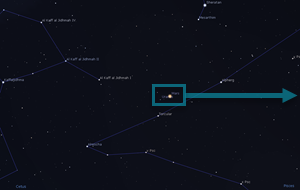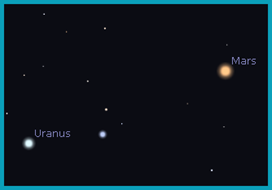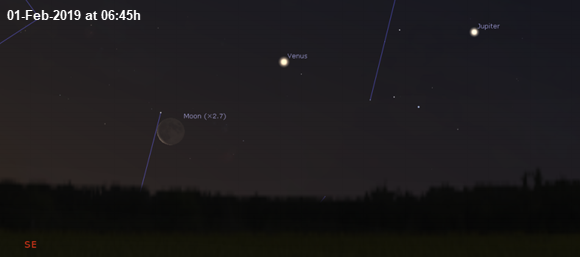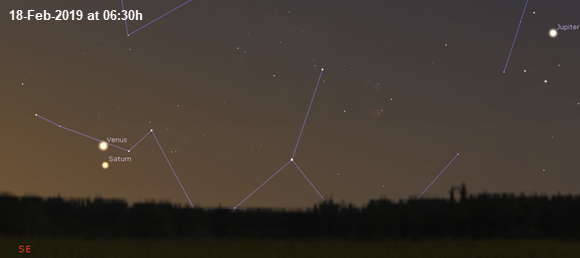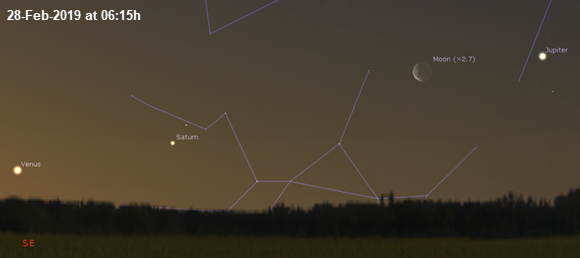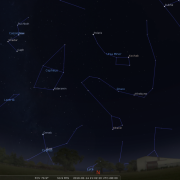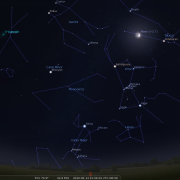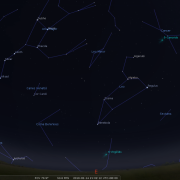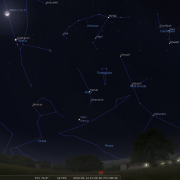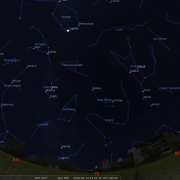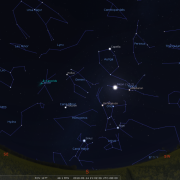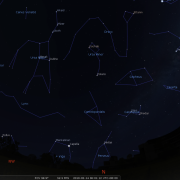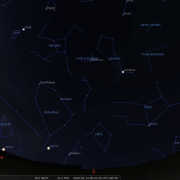In this month's Sky Notes:
Planetary Skylights
Evening Planets
 Mars is still evading the clutches of twilight as we head through February, cutting across the ‘ribbon’ of Pisces and up into Aries. Look for the still rather conspicuous red planet in the SW on Feb 11th, 12th and 13th around 18:00h, when it passes close by distant Uranus, a great opportunity to spot the 7th planet out.
Mars is still evading the clutches of twilight as we head through February, cutting across the ‘ribbon’ of Pisces and up into Aries. Look for the still rather conspicuous red planet in the SW on Feb 11th, 12th and 13th around 18:00h, when it passes close by distant Uranus, a great opportunity to spot the 7th planet out.
 At Magnitude + 5.8 you probably won’t see Uranus with the naked eye, and even in binoculars it will only show up as a blurry apple white star lower left of Mars (12th). Through a telescope however, you can resolve the tiny 3.5 arc second disk, (Mars will be just under 6 arc seconds) and at very low eyepiece magnification both planets should fit into the same field of view, around one degree apart with a nice contrast of hues, orange and ghostly green! The Crescent Moon lies 6 degrees south of the pair on the 10th.
At Magnitude + 5.8 you probably won’t see Uranus with the naked eye, and even in binoculars it will only show up as a blurry apple white star lower left of Mars (12th). Through a telescope however, you can resolve the tiny 3.5 arc second disk, (Mars will be just under 6 arc seconds) and at very low eyepiece magnification both planets should fit into the same field of view, around one degree apart with a nice contrast of hues, orange and ghostly green! The Crescent Moon lies 6 degrees south of the pair on the 10th.
 Mercury arcs up into the evening twilight sky from mid February for its best apparition of the year reaching its greatest elongation east of the Sun on the 27th (18 degrees). Look for this elusive planet not far above the WSW horizon around 17:45-18:00h. It will be brightest at the start of the apparition (Mag 1.2), bright enough to quite easily spot with the naked, but it will lie closer to the horizon (by a few degrees) so a clear unobstructed aspect is a pre-requisite. If it does elude your eyes, use binoculars to help spot it, compass bearing 250 degrees. As the month progresses Mercury will gain in altitude but gradually diminish in brightness, and by the 27th should be almost 10 degrees above the horizon. Telescopically there is not a great deal to view, but you may notice the phase alter from a fat gibbous at the start of the apparition to a first quarter, by the start of March. A tip when observing is to try and view 45 minutes to 1 hour after sunset.
Mercury arcs up into the evening twilight sky from mid February for its best apparition of the year reaching its greatest elongation east of the Sun on the 27th (18 degrees). Look for this elusive planet not far above the WSW horizon around 17:45-18:00h. It will be brightest at the start of the apparition (Mag 1.2), bright enough to quite easily spot with the naked, but it will lie closer to the horizon (by a few degrees) so a clear unobstructed aspect is a pre-requisite. If it does elude your eyes, use binoculars to help spot it, compass bearing 250 degrees. As the month progresses Mercury will gain in altitude but gradually diminish in brightness, and by the 27th should be almost 10 degrees above the horizon. Telescopically there is not a great deal to view, but you may notice the phase alter from a fat gibbous at the start of the apparition to a first quarter, by the start of March. A tip when observing is to try and view 45 minutes to 1 hour after sunset.
Dawn Planets
We shall now turn to the dawn sky, where there is plenty of planetary action.

 Having swapped places with Jupiter after their spectacular conjunction last month, brilliant Venus continues to drift down toward the SE horizon encountering Saturn on the 18th coming the other way. Venus will lie above Saturn on this date, view around 07:00h. On Feb 2nd Saturn is occulted by the moon, unfortunately from our location only the re-emergence of Saturn will be visible as the moon rises around 06:40h.
Having swapped places with Jupiter after their spectacular conjunction last month, brilliant Venus continues to drift down toward the SE horizon encountering Saturn on the 18th coming the other way. Venus will lie above Saturn on this date, view around 07:00h. On Feb 2nd Saturn is occulted by the moon, unfortunately from our location only the re-emergence of Saturn will be visible as the moon rises around 06:40h.
 Jupiter continues to draw away from the SE horizon, and is a fine sight through a telescope. Look for the banded disk and the Galilean moons strung out nearby. Dates of interest when there is a shadow transit of a moon are:
Jupiter continues to draw away from the SE horizon, and is a fine sight through a telescope. Look for the banded disk and the Galilean moons strung out nearby. Dates of interest when there is a shadow transit of a moon are:
- Ganymede: February 2/3rd – 05:30h.
- Europa: 6/7th around 05:00h and again on the 13/14th when a shadow transit starts just after 06:00h.
- Finally Io: has shadow transits on the 7/8th and 23/24th around 06:00h.
- The Great Red Spot is favourably placed to observe on the disk on the following dates: Feb 7/8th, 9/10th, 14/15th, 19/20th, 24/25th and 26/27th. View 04:45-06:00h.
 Finally a waning Crescent Moon passes through this part of the dawn sky on the 1st and 2nd and again from 28th Feb to 2nd March. Speaking of The Moon, the full Moon on the 19th is yet another ‘super moon’, the popular name given to any perigee full moon; ie one that is slightly closer to the earth at that phase. (We’ll be having super new moons next!) At this particular one the moon will lie at a distance from earth of 357,967km and will be 33 arc minutes and 25 arc seconds in apparent diameter.
Finally a waning Crescent Moon passes through this part of the dawn sky on the 1st and 2nd and again from 28th Feb to 2nd March. Speaking of The Moon, the full Moon on the 19th is yet another ‘super moon’, the popular name given to any perigee full moon; ie one that is slightly closer to the earth at that phase. (We’ll be having super new moons next!) At this particular one the moon will lie at a distance from earth of 357,967km and will be 33 arc minutes and 25 arc seconds in apparent diameter.
Meteors

There is just one minor meteor shower this month, the Alpha Aurigids. The peak (if you can call it that) falls between Feb 6-9th. The Zenith Hourly Rate only reaches sporadic levels, barely half a dozen per hour, but if you do spot a meteor heading away from the direction of the zenith, (overhead) where the constellation of Auriga resides at this time of year, it is likely to be an Aurigid!
February 2019 Sky Charts
|
Looking North
Mid-February - 21:00h |
Looking South |
|
Looking East
Mid-February - 21:00h |
Looking West
Mid-February - 21:00h |
|
Northern Aspect
Mid-February - 21:00h |
Southern Aspect
Mid-February - 21:00h |
| Looking North (Early) Mid-February - 06:00h |
Looking South (Early) Mid-February - 06:00h |
Additional Image Credits:
- Planets and Comets where not otherwise mentioned: NASA
- Sky Charts: Stellarium Software
- Log in to post comments

